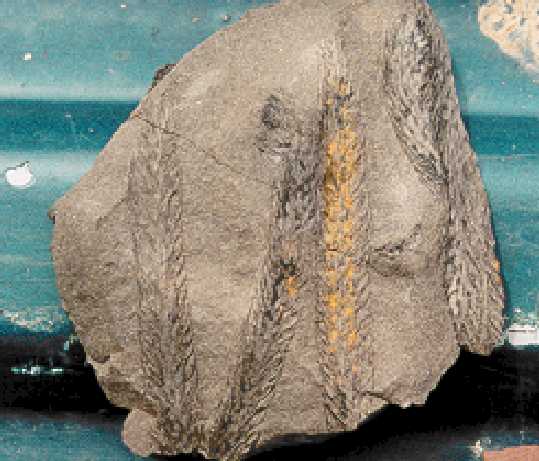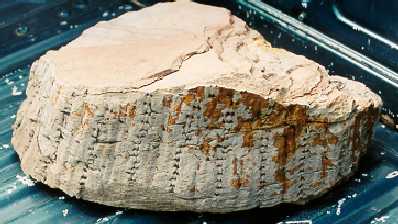Department of Physics and Astronomy
University of Alabama
Tuscaloosa, Alabama
The field trip on May 29, 1999, was to an abandoned strip mine in Kimberly that is now being re-excavated by the owner of the Warrior site which was described in the report of the March 27, 1999, BPS field trip. This is a new site for the BPS and we were most likely the first people to seriously look for fossils in the area, at least since the mine was active.
Although the postcard for the trip stated that we would be visiting the same Warrior site as on March 27, it was understood at the last BPS meeting that we would visit the new site and check it out. We decided to visit the new site first and left it as an option for attendees to visit the site on their own, since that site is much easier to find. About 15 people, including BPS members and guests, attended today's field trip.
--Edited by Vicki Lais
|
Ferns seemed less abundant, but good specimens were found nonetheless. Finely detailed fossils of the top foliage of arborescent lycopods were found in abundance. Bark impressions of Lepidodendron and Sigillaria were also found. The main difference between this site and the Warrior site is that the fossils at the latter site are concentrated in a small area that is easy to explore. At the Kimberly site, the fossils were spread out over a much larger area and finding them required a great deal of tenacious searching. Also, since you could not necessarily drive your vehicle up any of the steep hills, carrying a large fossil to your car was challenging to say the least. |
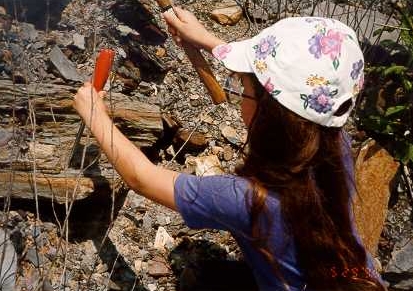 There were numerous highlights of this trip. One attendee showed me a rare (so far as I know) cast fossil of a small part of a stem of Cordaites, a gymnospermous tree with no modern relatives. The stem of this tree consists of a series of horizontal ridges and is easily distinguished from Calamites, but I had never seen one this nice before. Some very nice pieces of Calamites itself were found. The inimitable Ken Hoyle showed several of us two spectacular Calamites casts he found, each about 6 inches long and 4-5 inches in diameter. The two pieces were obviously part of the same plant, but he could not find any of the missing parts. There were numerous highlights of this trip. One attendee showed me a rare (so far as I know) cast fossil of a small part of a stem of Cordaites, a gymnospermous tree with no modern relatives. The stem of this tree consists of a series of horizontal ridges and is easily distinguished from Calamites, but I had never seen one this nice before. Some very nice pieces of Calamites itself were found. The inimitable Ken Hoyle showed several of us two spectacular Calamites casts he found, each about 6 inches long and 4-5 inches in diameter. The two pieces were obviously part of the same plant, but he could not find any of the missing parts.
|
||
Steve, Dena, and Molly Hand were also very successful in finding good 3D casts of Calamites, as well as a nice piece of Asterophyllites equisetiformis, the characteristic foilage of the branches of Calamites. Ken Wills, who previously spoke to the BPS last year, found a nice piece with many Calamostachys impressions, representing the cones of Calamites. Christina and Larry Hensley found a big rock with a stunning impression of the bark of a Lepidendron arborescent lycopod. It was beautiful but too big for anyone to carry. 3D casts of the rhizophore of Stigmaria ficoides, the root system of arborescent lycopods, were also found by several attendees, including myself. The largest, 15 inches long, was found by Bruce Relihan.
|
Particularly interesting were the stump fossils found at this site. On the top of a hill, I found three fossil stumps of Sigillaria. All three pieces showed the characteristic parallel bands of parichnos scars. The two largest pieces are about a foot in diameter and 3 to 6 inches thick. A smaller piece showed the strongest bands. I managed to get these to my car with difficulty, and needed help with one piece. Gerry Badger had a tougher time, however. He found a much bigger stump of Lepidodendron and practically had to roll it down to his car from some distant point. The stump looked to be 70-80 lbs in weight and showed weak scars. A very much larger stump was found by several others near the base of a hill. I heard it was maybe 30 inches in diameter. But by the time I heard about it, I had no energy to go and see it! Ken Wills and Bruce Relihan also found partial stump casts. In summary, this was quite an interesting field trip. When I first "scouted" out this site in April, I was not sure we would find much since casual searching during a period of one hour did not reveal many fossils. The intensive searching by attendees on this trip was much more revealing about the site, and showed it to really be nearly as good as the Warrior site. It will be worthy of a second visit in the future. |
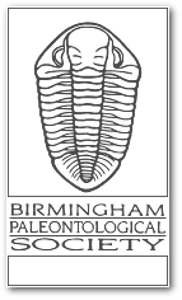
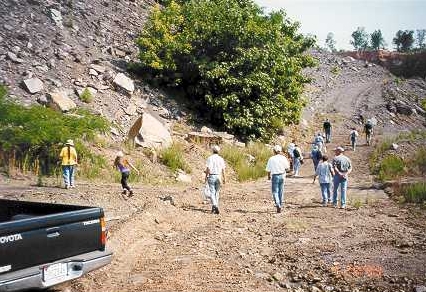 The site turned out to be a particularly good one for finding a variety of Carboniferous period plant fossils. The area was so vast that even with 15 people we really did not explore it all. Many rock piles surround an open area where we could park our vehicles. Fossils of Calamites, including 3D stem casts, stem impressions, foliage, and cones were abundant in some areas.
The site turned out to be a particularly good one for finding a variety of Carboniferous period plant fossils. The area was so vast that even with 15 people we really did not explore it all. Many rock piles surround an open area where we could park our vehicles. Fossils of Calamites, including 3D stem casts, stem impressions, foliage, and cones were abundant in some areas.